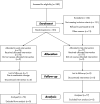Cueing training in the home improves gait-related mobility in Parkinson's disease: the RESCUE trial
- PMID: 17229744
- PMCID: PMC2077658
- DOI: 10.1136/jnnp.200X.097923
Cueing training in the home improves gait-related mobility in Parkinson's disease: the RESCUE trial
Erratum in
- J Neurol Neurosurg Psychiatry. 2010 Dec;81(12):1414
- J Neurol Neurosurg Psychiatry. 2010 Jan;81(1):126
Abstract
Objectives: Gait and mobility problems are difficult to treat in people with Parkinson's disease. The Rehabilitation in Parkinson's Disease: Strategies for Cueing (RESCUE) trial investigated the effects of a home physiotherapy programme based on rhythmical cueing on gait and gait-related activity.
Methods: A single-blind randomised crossover trial was set up, including 153 patients with Parkinson's disease aged between 41 and 80 years and in Hoehn and Yahr stage II-IV. Subjects allocated to early intervention (n = 76) received a 3-week home cueing programme using a prototype cueing device, followed by 3 weeks without training. Patients allocated to late intervention (n = 77) underwent the same intervention and control period in reverse order. After the initial 6 weeks, both groups had a 6-week follow-up without training. Posture and gait scores (PG scores) measured at 3, 6 and 12 weeks by blinded testers were the primary outcome measure. Secondary outcomes included specific measures on gait, freezing and balance, functional activities, quality of life and carer strain.
Results: Small but significant improvements were found after intervention of 4.2% on the PG scores (p = 0.005). Severity of freezing was reduced by 5.5% in freezers only (p = 0.007). Gait speed (p = 0.005), step length (p<0.001) and timed balance tests (p = 0.003) improved in the full cohort. Other than a greater confidence to carry out functional activities (Falls Efficacy Scale, p = 0.04), no carry-over effects were observed in functional and quality of life domains. Effects of intervention had reduced considerably at 6-week follow-up.
Conclusions: Cueing training in the home has specific effects on gait, freezing and balance. The decline in effectiveness of intervention effects underscores the need for permanent cueing devices and follow-up treatment. Cueing training may be a useful therapeutic adjunct to the overall management of gait disturbance in Parkinson's disease.
Conflict of interest statement
Competing interests: The proceeds of the sale of the CD‐Rom will be used to fund completion of analysis of the full RESCUE dataset. We may be involved in this further work.
Comment in
-
Cueing training in persons with Parkinson's disease.J Neurol Neurosurg Psychiatry. 2007 Feb;78(2):111. doi: 10.1136/jnnp.2006.104794. J Neurol Neurosurg Psychiatry. 2007. PMID: 17229740 Free PMC article.
-
Cueing training in the home improves mobility in Parkinson's disease.Aust J Physiother. 2007;53(4):285. doi: 10.1016/s0004-9514(07)70011-9. Aust J Physiother. 2007. PMID: 18246632 No abstract available.
References
-
- Grimbergen Y, Munneke M, Bloem B R. Falls in Parkinson's disease. Review. Curr Opin Neurol 200417405–415. - PubMed
-
- Deane K H O, Jones D, Clarke C E.et al Physiotherapy versus placebo or no intervention in Parkinson's disease. Cochrane Database Syst Rev. 2001b: CD 002817 (3)
-
- Rubinstein T, Giladi N, Hausdorff J. The power of cueing to circumvent dopamine deficits: a review of physical therapy treatment of gait disturbances in Parkinson's disease. Mov Disord 2002171148–1160. - PubMed
Publication types
MeSH terms
LinkOut - more resources
Full Text Sources
Other Literature Sources
Medical

